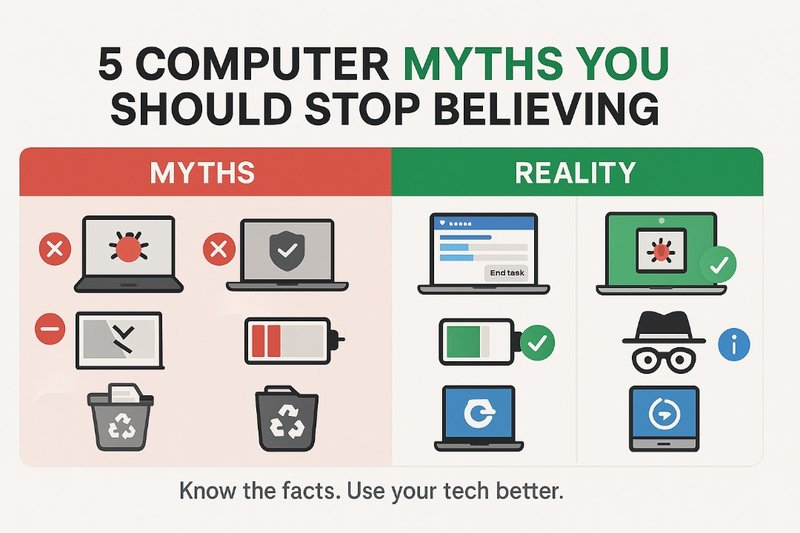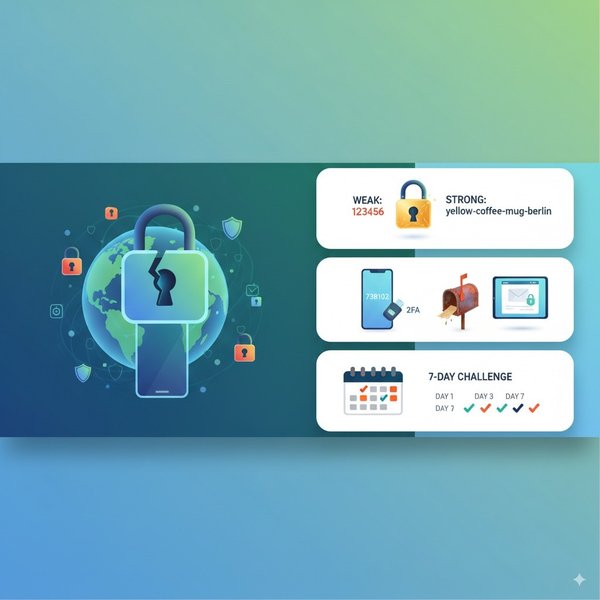Introduction
In a world dominated by digital technology, it’s easy to pick up ideas and assumptions about computers that sound logical but aren’t actually true. These myths, often passed around for years, can lead to bad habits, poor decisions, and even data loss. Knowing the truth about how computers work not only helps you use them more effectively, but also protects you from unnecessary risks. This article breaks down five of the most common computer myths and explains why you should stop believing them.
1. A Slow Computer Always Means a Virus
One of the most common assumptions people make when their computer slows down is that it must be infected with a virus. While malware can certainly affect performance, it’s far from the only reason a system might become sluggish.
In most cases, the slowdown is caused by other factors such as:
-
Too many programs running in the background
-
A cluttered or nearly full hard drive
-
Insufficient RAM
-
Outdated drivers
-
Dust buildup causing thermal throttling
The more applications running at startup, the more memory your system uses before you even begin working. Over time, temporary files and leftover system data can also weigh down your system.
Before assuming the worst, open the Task Manager to check which programs are consuming system resources. Cleaning up your disk, disabling unnecessary startup items, and upgrading to an SSD can often restore speed without involving any malware at all.
2. Macs Don’t Get Viruses
Many users believe that macOS is immune to viruses and other malicious software. This myth has been around for years, mostly because historically, Windows had a larger market share and was a more attractive target for hackers. However, as Macs have become more popular, they have increasingly attracted attention from cybercriminals.
Macs are vulnerable to a wide range of threats, including:
-
Spyware
-
Ransomware
-
Phishing attacks
-
Adware
While macOS has built-in security features like Gatekeeper and XProtect, these do not offer complete protection. Users still need to be cautious about the websites they visit, the files they download, and the permissions they grant to applications.
To stay protected, Mac users should install system updates regularly, use a trusted antivirus program, and avoid downloading software from unverified sources.
3. You Need to Let Your Battery Fully Drain Before Recharging
This myth dates back to older battery technologies like nickel-cadmium (NiCad) and nickel-metal hydride (NiMH), which suffered from the “memory effect”—a condition where batteries "forgot" their full capacity if they weren’t discharged completely. However, modern devices use lithium-ion batteries, which do not suffer from this problem.
In fact, regularly allowing a lithium-ion battery to fully discharge can reduce its lifespan. These batteries work best when kept between 20% and 80% charge. Frequent deep discharges and continuous overcharging can both contribute to faster degradation.
It is fine to plug in your device when it’s at 40%, 60%, or even 80%. Most modern laptops and smartphones are designed to stop charging once the battery reaches full capacity. For optimal battery health, avoid exposing your device to extreme heat and try not to keep it at 100% or 0% for extended periods.
4. Private or Incognito Mode Keeps You Completely Anonymous
Private browsing modes, such as Incognito in Chrome or Private Window in Firefox, are often misunderstood. While these modes prevent your browser from storing browsing history, cookies, and form data on your local device, they do not make your internet activity invisible.
Even when using private mode, the following entities can still monitor your activity:
-
Your Internet Service Provider (ISP)
-
Your employer or school (on managed networks)
-
The websites you visit
-
Advertisers using tracking tools and browser fingerprinting
Private browsing is useful for local privacy—such as when you're using a shared computer or want to prevent browser autofill—but it does not offer true anonymity. For higher levels of privacy, you would need to use tools like a Virtual Private Network (VPN) or browsers specifically designed to block trackers and mask user identity.
5. Emptying the Recycle Bin Erases Files Permanently
When you delete a file and empty the Recycle Bin, it may seem like the file is gone for good. However, deleting a file in this way only removes its reference in the file system. The actual data remains on the hard drive until it is overwritten by new information.
This means that with the right recovery tools, deleted files can often be restored. This is particularly concerning when disposing of old computers or hard drives that contain sensitive personal or financial information.
To securely delete files, use secure deletion tools or disk-wiping software that overwrite the file’s data with random bits, making recovery extremely difficult or impossible. Many operating systems have built-in utilities for secure deletion, and additional software options are widely available.
Conclusion
Computer myths persist because they are often repeated without being questioned. Believing in these myths can lead to unnecessary worry, wasted time, and even compromised security. By understanding the reality behind common misconceptions, you can make better decisions, optimize your system's performance, and stay safer online. Replacing outdated beliefs with accurate knowledge is one of the most effective upgrades any computer user can make.
Lets know your taughts in the comment section, has these clear your worries?




Comments (0)
Leave a Comment
No comments yet. Be the first to comment!